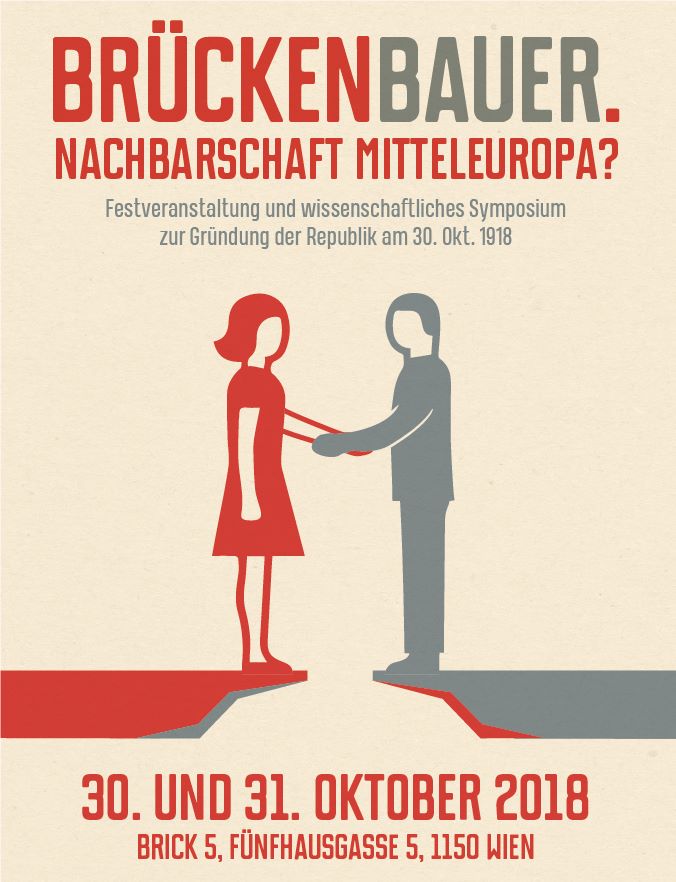To mark the 100th anniversary of the Austrian Republic, transform! europe and the Jahoda-Bauer Institute held a conference about the prospects for a common strategy for the Danube region and Central Europe. The event was supported financially by the Republic of Austria’s Fund for the Future and the Party of the European Left.
We discussed contemporary political developments in Europe, on the basis of the deliberations in Otto Bauer’s manuscript, Die österreichische Revolution [The Austrian Revolution] (1923), in which he discussed the social and democratic upheavals of 1918. In view of the EU Council Presidency, which was taking place concurrently, the main focus was on topics such as Bauer’s transformation theories and the conflict he felt with regard to the “national question”, which have become highly topical in the face of resurgent nationalism.
The proceedings began on 30th October with an evening event to celebrate the 100th anniversary of the First Republic of Austria. In her opening speech, political scientist Tamara Ehs recalled that, on 30th October 1918, the Provisional National Assembly adopted the principles elaborated by Karl Renner, which henceforth formed the first constitution of the Republic. With respect to day-to-day politics Ehs reminded us that, today, we are facing growing nationalism; and she observed that right-wing authoritarianism can only be challenged if the new social issue is resolved. As a guideline for action, she declared that the struggle for the primacy of politics over the economy must be resumed and financialised globalisation must be harnessed just as social democracy had done 100 years ago with regards to capitalism.
Following the speech by Tamara Ehs, the writer Andreas Pittler read passages from his book Wiener Kreuzweg [Viennese crossroad] and described the political events between 1918 and 1938. He was followed by historian Georg Spitaler (Verein für Geschichte der ArbeiterInnenbewegung, VGA) [Association for the History of the Workers’ Movement, VGA], who gave an overview of the VGA’s Otto Bauer collection and called the audience’s attention to the Rotes Wien [Red Vienna] exhibition, which will be showing at Vienna Museum from 30th April 2019. Following this the sociologist Ksenija Vidmar Horvat (University of Ljubljana) gave the keynote speech on Central Europe, Austro-Marxism and Progressive Europe and recalled commonly held and shared Austro-Marxist traditions of knowledge and activity in Austria and the post-socialist region. Her talk acted as an initial launching pad for the topics that would be dealt with during the scientific conference that started the following day.
Walter Baier (transform! europe) presented his research on the issue of the relevance of Otto Bauer and Austro-Marxism – please find Walter Baiers lecture on the right (pdf) -, before subsequently moderating a podium discussion on this same topic. On the rostrum, Marcus Strohmeier (International Department at the ÖGB [Austrian Trade Union Federation]), Gáspár Miklós Tamás (philosopher and former politician, Hungary), Georg Hubmann (Jahoda-Bauer Institute, Linz) and Eva Maltschnig (Sektion 8, SPÖ [Social Democratic Party of Austria]) discussed their personal approaches to Austro-Marxist theory and practice.
The evening concluded with a performance by the brass ensemble Politische Blaskapelle IMI (Institute for Musicology and Interpretation Research at the University of Music and Performing Arts Vienna) under the direction of University Professor Christian Glanz. In addition to the national anthem of the First Republic (1920-1929) Deutschösterreich, du herrliches Land [German Austria, you magnificent country] (music: Wilhelm Kienzl, text: Karl Renner), which is seldom heard today, the ensemble played the best of Hanns Eisler and Bertolt Brecht (Lied von der Unzulänglichkeit menschlichen Strebens, Einheitsfrontlied, Lied der Kupplerin, Solidaritätslied) [Song of the Inadequacy of Human Striving, United Front Song, The Matchmaker’s Song, Song of Solidarity] and recalled the unfailingly political component of art and its significance in the workers’ movement.
The following day (31st October) was dedicated to two panels for academic debate. In the morning, Günther Sandner (University of Vienna), Ksenija Vidmar Horvat (University of Ljubljana), Joanna Gwiazdecka (Rosa Luxemburg Foundation) and Gábor Egry (Institute of Political History, Budapest) talked about shared traditions of knowledge and activity of Austro-Marxism in Central Europe, in a discussion moderated by Walter Baier. While Sandner set out in principle what Austro-Marxism really meant in theory and practice, Ksenija Vidmar Horvat continued her remarks from the previous evening, specifically focussing on the reception of Austro-Marxism in Slovenia. Joanna Gwiazdecka gave an overview of the adoption and development of Austro-Marxist ideas in Poland and Czechoslovakia, while Gábor Egry concentrated on Hungary and, in particular, provided a critique of Otto Bauer’s citizenship programme with regard to the minorities living in Hungary.
The afternoon was dedicated to the relevance of Otto Bauer and Austro-Marxism for European integration. Mario Holzner (Wiener Institut für Internationale Wirtschaftsvergleiche, wiiw) [Vienna Institute for International Economic Studies], Silvia Nadjivan (Institut für den Donauraum und Mitteleuropa, IDM) [Institute for the Danube Region and Central Europe, IDM], Ephraim Nimni (Queens University Belfast) and Michael Löwy (Centre national de la recherche scientifique, CNRS, Paris) [French National Centre for Scientific Research, CNRS] debated the compatibility of Otto Bauer’s oeuvre in a discussion moderated by Barbara Steiner (transform! europe).
The scientific discussion was followed by a final political assessment by the science historian Helena Sheehan (Dublin City University) and Mirko Messner (federal spokesman for the Communist Party of Austria, KPÖ).
The full series talks from the conference will appear in anthology form in 2019, published by Mandelbaum Verlag.
